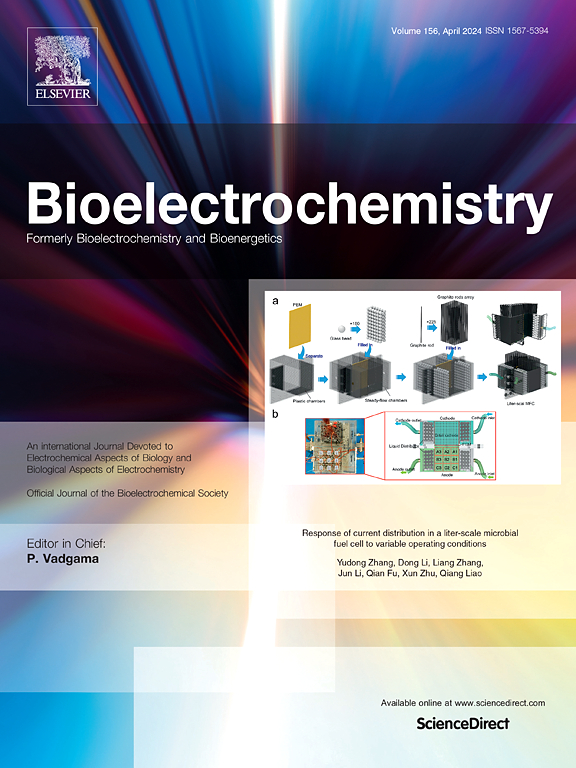用通道蛋白和肽将纳米结构双分子层系在电极表面的时间分辨机电和导电行为。
IF 4.8
2区 化学
Q1 BIOCHEMISTRY & MOLECULAR BIOLOGY
引用次数: 0
摘要
通过计时器和阻抗光谱技术,电化学研究了线粒体内膜钾通道和通道形成肽--苎麻素对系在金电极上的模型脂膜的离子传输和机电特性的影响。在钾通道的情况下,使用通道特异性抑制剂--ATP-Mg2+ 复合物来调节离子传输特性;而在gramicidin 肽的情况下,则使用钠离子取代钾离子。观察到的所研究系统的两个指数电流-时间反应被解释为离子渗透和系留脂质双分子层膜的电致伸缩,结论得到了沉积在金上的不同烷硫醇链长度的烷硫醇自组装单层实验的支持。本文章由计算机程序翻译,如有差异,请以英文原文为准。
Time-resolved electromechanical and conductive behavior of nanostructured bilayers tethered to the surface of the electrode with incorporated channel proteins and peptides
The influence of incorporation of mitochondrial inner membrane potassium channel, and channel-forming peptide – Gramicidin on the ion transport and electromechanical properties of model lipid membranes tethered to gold electrode was electrochemically investigated by chronoamperometric and impedance spectroscopy techniques. In the case of the potassium channel the ion transport properties were modulated with channel-specific inhibitor – ATP-Mg2+ complex, whereas in the case of gramicidin peptide – by replacing potassium with sodium ions. The observed two exponential current–time responses of the systems studied were interpreted in terms of ion penetration and electrostriction of tethered lipid bilayer membrane, and conclusions supported with the experiments on alkanethiol self-assembled monolayers of different alkanethiol chain lengths deposited on gold.
求助全文
通过发布文献求助,成功后即可免费获取论文全文。
去求助
来源期刊

Bioelectrochemistry
生物-电化学
CiteScore
9.10
自引率
6.00%
发文量
238
审稿时长
38 days
期刊介绍:
An International Journal Devoted to Electrochemical Aspects of Biology and Biological Aspects of Electrochemistry
Bioelectrochemistry is an international journal devoted to electrochemical principles in biology and biological aspects of electrochemistry. It publishes experimental and theoretical papers dealing with the electrochemical aspects of:
• Electrified interfaces (electric double layers, adsorption, electron transfer, protein electrochemistry, basic principles of biosensors, biosensor interfaces and bio-nanosensor design and construction.
• Electric and magnetic field effects (field-dependent processes, field interactions with molecules, intramolecular field effects, sensory systems for electric and magnetic fields, molecular and cellular mechanisms)
• Bioenergetics and signal transduction (energy conversion, photosynthetic and visual membranes)
• Biomembranes and model membranes (thermodynamics and mechanics, membrane transport, electroporation, fusion and insertion)
• Electrochemical applications in medicine and biotechnology (drug delivery and gene transfer to cells and tissues, iontophoresis, skin electroporation, injury and repair).
• Organization and use of arrays in-vitro and in-vivo, including as part of feedback control.
• Electrochemical interrogation of biofilms as generated by microorganisms and tissue reaction associated with medical implants.
 求助内容:
求助内容: 应助结果提醒方式:
应助结果提醒方式:


